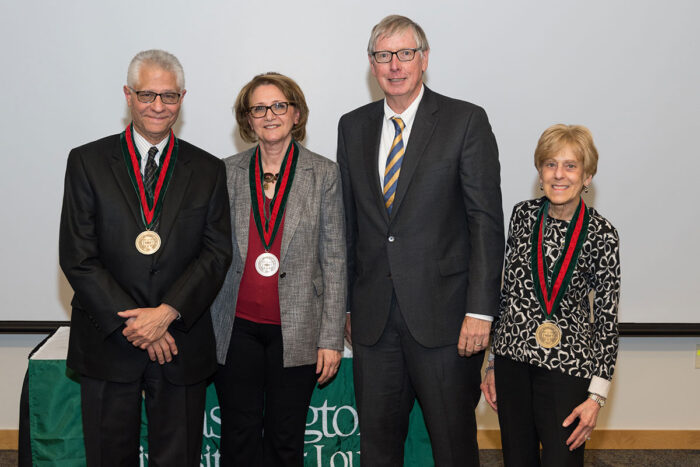Dehdashti named Siegel Professor of Radiology
Recognized for using imaging to diagnose cancer, guide treatments
 Mark Beaven
Mark BeavenFarrokh Dehdashti, MD, has been named the inaugural Drs. Barry A. and Marilyn J. Siegel Professor in Radiology at Washington University School of Medicine in St. Louis. Pictured are (from left): Barry Siegel, MD; Dehdashti; Richard L. Wahl, MD, head of the Department of Radiology; and Marilyn Siegel, MD.
Farrokh Dehdashti, MD, a professor of radiology at Washington University School of Medicine’s Mallinckrodt Institute of Radiology (MIR), has been named the inaugural Drs. Barry A. and Marilyn J. Siegel Professor in Radiology.
Dehdashti is credited with expanding the role of positron emission tomography (PET) in the field of oncology. She conducted some of the first studies in people of several novel PET diagnostic compounds related to several types of cancers, including cervical, breast, pancreatic and prostate cancers.
Dehdashti was installed by then-Chancellor Mark S. Wrighton and David H. Perlmutter, MD, executive vice chancellor for medical affairs, the George and Carol Bauer Dean of the School of Medicine, and the Spencer T. and Ann W. Olin Distinguished Professor of Medicine.
“Drs. Barry and Marilyn Siegel are not only accomplished radiologists who have pushed the boundaries of scientific discovery to advance human health, they are also philanthropists who have given generously to support the future of medicine,” said Wrighton, who is now chancellor emeritus. “In addition to establishing this professorship, their gifts to the annual fund, lectureships and other needs at Mallinckrodt Institute of Radiology and Washington University extend all the way back to 1973.”
While studying the role of steroid hormones in breast cancer, Dehdashti found that PET scans using a modified form of estrogen can be used to predict response to endocrine therapy. That work was groundbreaking in its potential to save patients from having to undergo numerous invasive biopsies and being treated with an ineffective endocrine therapy.
“Dr. Dehdashti is a gifted scientist who has made transformative contributions to diagnosing and treating cancer,” said Chancellor Andrew D. Martin. “She exemplifies our WashU mission to pursue excellence and improve lives. We are extremely fortunate to have the opportunity to recognize and support her outstanding work with this endowed professorship.”
Also a senior vice chair of radiology and director of the Division of Nuclear Medicine, Dehdashti leads a translational effort to use PET to detect low oxygen levels in tumors. Her work is driven by data showing that patients whose tumors have low oxygen levels are less likely to survive than those whose tumors have normal oxygen levels.
“As the Drs. Barry A. and Marilyn J. Siegel Professor of Radiology, Farrokh Dehdashti will have additional, lasting support to pursue knowledge and understand diseases in ways never before possible,” Perlmutter said. “I give my sincerest thanks to Marilyn and Barry Siegel for their special degree of devotion to Washington University School of Medicine and the work that is continually changing the future of medicine.”
Added Richard L. Wahl, MD, the Elizabeth E. Mallinckrodt Professor and head of the Department of Radiology and director of MIR: “Dr. Dehdashti is a world-class physician-scientist whose innovative research in PET imaging drives and informs precision cancer treatment. She is a gifted physician and educator, and plays a major departmental leadership role as a senior vice chair at MIR.”
Dehdashti earned her medical degree from Pahlavi University School of Medicine in Iran in 1977 and completed her radiology residency in 1980 at the same institution. She served as chief resident and then research fellow in PET imaging in the Division of Nuclear Medicine at Washington University School of Medicine before joining the faculty in 1990.
The endowed professorship honors the accomplishments of Barry A. Siegel, MD, and Marilyn J. Siegel, MD, longstanding faculty in the Department of Radiology. The two met and married while working at MIR. Marilyn Siegel, the first female professor of radiology and a professor of pediatrics, helped develop computed tomography (CT) into a tool that has changed patient treatment and outcomes. She has worked tirelessly to reduce children’s exposure to radiation during CT scans. An internationally recognized expert on diagnostic imaging of children, she has received invitations to speak all over the world. The Society of Computed Body Tomography and Magnetic Resonance Imaging recognized her accomplishments with the Gold Medal, its highest award.
Barry Siegel, a professor of radiology and of medicine, is known for his groundbreaking contributions related to the diagnosis of blockages in lung arteries, the detection of blood clots, and using radioactive tracers to detect tumors. A former senior vice chair and director of the Division of Nuclear Medicine, his research has focused on uses of PET for cancer diagnosis and staging, as well as predicting and monitoring tumor response to therapy. He played a leading role in working with the Centers for Medicare & Medicaid Services to set up a national registry that allowed for expanded access to PET for clinical applications in oncology. In 2014, he was awarded the Benedict Cassen Prize, the highest honor in nuclear medicine.








